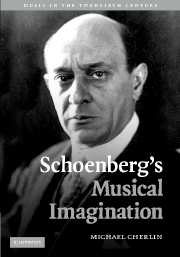Book contents
- Frontmatter
- Contents
- List of music examples and figures
- Acknowledgements
- Introduction
- 1 A passing of worlds: Gurrelieder as Schoenberg's reluctant farewell to the nineteenth century
- 2 Dialectical opposition in Schoenberg's music and thought
- 3 Dramatic conflict in Pelleas und Melisande
- 4 Motive and memory in Schoenberg's First String Quartet
- 5 Uncanny expressions of time in the music of Arnold Schoenberg
- 6 The tone row as the source of dramatic conflict in Moses und Aron
- 7 The String Trio: metaleptic Schoenberg
- Notes
- Bibliography
- General index – names and topics
- Index of Schoenberg's works and writings
3 - Dramatic conflict in Pelleas und Melisande
Published online by Cambridge University Press: 22 September 2009
- Frontmatter
- Contents
- List of music examples and figures
- Acknowledgements
- Introduction
- 1 A passing of worlds: Gurrelieder as Schoenberg's reluctant farewell to the nineteenth century
- 2 Dialectical opposition in Schoenberg's music and thought
- 3 Dramatic conflict in Pelleas und Melisande
- 4 Motive and memory in Schoenberg's First String Quartet
- 5 Uncanny expressions of time in the music of Arnold Schoenberg
- 6 The tone row as the source of dramatic conflict in Moses und Aron
- 7 The String Trio: metaleptic Schoenberg
- Notes
- Bibliography
- General index – names and topics
- Index of Schoenberg's works and writings
Summary
It was around 1900 when Maurice Maeterlinck fascinated composers, stimulating them to create music to his dramatic poems. What attracted all was his art of dramatizing eternal problems of humanity in the form of fairy-tales, lending them timelessness without adhering to imitation of ancient styles.
I had first planned to convert Pelleas and Melisande into an opera, but I gave up this plan, though I did not know Debussy was working on an opera at the same time. I still regret that I did not carry out my initial intention. It would have differed from Debussy's. I might have missed the wonderful perfume of the poem; but I might have made my characters more singing.
On the other hand the symphonic poem helped me, in that it taught me to express moods and characters in precisely formulated units, a technique which an opera would perhaps not have promoted so well.
Thus my fate evidently guided me with great foresight.
Arnold Schoenberg, February 17, 1950In December of 1901, Schoenberg moved from Vienna to Berlin having accepted a position as musical director at the relatively new and highly successful Überbrettl cabaret. Schoenberg would stay in Berlin until the summer of 1903. It was during this period that he became acquainted with Richard Strauss, and it was Strauss who suggested that Schoenberg set Maeterlinck's drama.
- Type
- Chapter
- Information
- Schoenberg's Musical Imagination , pp. 68 - 154Publisher: Cambridge University PressPrint publication year: 2007

